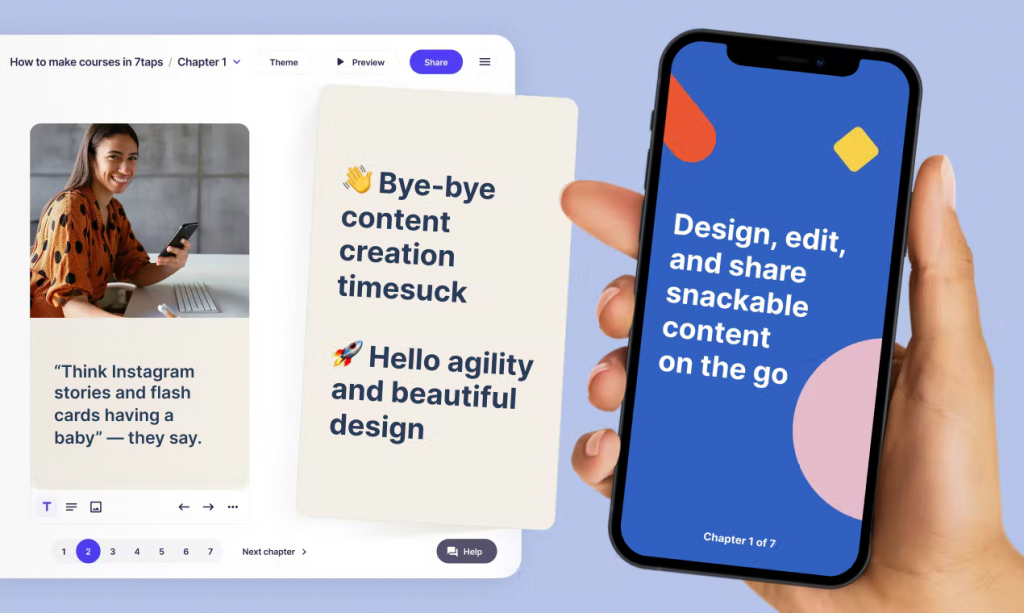Not every business can afford to make a huge investment in LMS or LXP. As a consequence, you could be interested in microlearning platforms if your company scale stays within under 50 employees and won’t be creating elaborate training programs or receiving thorough analytical results. Microlearning platforms enable you to create bite-sized material and swiftly distribute it to your learners. But how can you know which microlearning software will provide you with the best return on your investment? Take a look at a few of the best microlearning platforms that will change the fate of your company training scheme forever.
Microlearning is better for your budget and your learners
The definition
Microlearning is a type of educational strategy in which learners are given bite-sized, little learning units with just enough information to help them reach a goal. It’s the current term in the world of eLearning and instructional design. As with other eLearning-related phrases, it has some ambiguity or flexibility, if you choose. It’s a term used to describe a variety of learning methods. To a greater or lesser extent, all, however, have a few similar characteristics:
- Microlearning is done in small bursts of time.
- Individual sessions need very little effort.
- It entails subjects that are basic and/or limited.
Preparation Checklist to Power your Digital Transformation
Wondering if you miss anything in your preparation to digitize your training? This is just what you need.
The benefits
1. It takes less time to deliver
Shorter course delivery times result from fewer items to write. In an hour, you may create a course with hundreds of lessons using microlearning. This enables you to adapt more quickly to shifting company objectives and new training requirements.
2. It Is inexpensive
Producing a microlearning course is also far less expensive. It needs fewer resources and teachers. To develop your material, you don’t need any special “microlearning tools”; a standard LMS content editor would suffice – however a specialist microlearning-based platform like TalentLMS will make the process much easier.
3. It’s adaptable
Microlearning courses can cover every topic covered in standard eLearning courses but in a more bite-sized format. You may develop courses that provide a high-level overview of a topic.
4. It is more engaging for learners
Micro-training is the most engaging technique of training delivery. When compared to the “serious study” vibe of traditional training, microlearning seems like browsing your favorite social app on your smartphone.
5. It Improves retention of Information
Based on a study by RPS Research, you retain information much better when you study it frequently and return it when you are on the verge of losing it. Because microlearning units are tiny, self-contained, and easy to return to, they are ideal for such repetitive study.
6. It provides more freedom to learners
Regular online training with text-heavy courses is not conducive to learning in short bursts. Microlearning, on the other hand, allows your employees to learn on the go whenever they have free time.
Recommend reading:
7 most high-quality content authoring tools for 2022
To assist you in optimizing your training experience, we’ve developed a list of microlearning tools hand down the best ones. Check through our reviews to find which one is the greatest fit for you.
1. iSpring Learn
iSpring Learn is a straight-up one of the best microlearning platforms that automates and streamlines corporate training. It has a built-in writing tool for creating responsive content with knowledge tests that operate on both smartphones and desktop computers. You can also use the platform to upload pre-made SCORM courses, PPT presentations, videos, and other learning resources, then transfer to your learners and employees easily, and measure how your learners interact with the information. With iSpring Learn, users can learn whenever and wherever they choose, even while they are offline.
2. iSpring Page
It is a cloud-based micro-course creation tool. Create courses using Page in the same way you would a Facebook post — simply type (or paste) text, add media, and finally post. You may share the material with other editors so they can update the text and alter the course design if you have coworkers working on the course with you. The application allows you to simply publish material to SCORM or xAPI and deliver it to learners via an LMS. The courses run well on all platforms, including smartphones, tablets, and computers.
3. EduMe
EduMe refers to a mobile-based method of learning that combines both communication and training. It comes with a simple content creation tool that allows you to create your bite-sized courses, quizzes, and surveys easily. You may use EduMe to offer classes to your employees’ devices and keep track of their progress. A message creation tool is also included in the platform, allowing you to quickly produce breaking news about products promotions and send them to your colleagues right away or schedule them for later.
Recommend reading:
4. OttoLearn
This is one of the learning and development tools that allow users to create and distribute bite-sized material with ease. It enables you to give learner-centered training by allowing employees to pick the topics they want to study and how in-depth they want to study them. The program will automatically assign the required exercises to each employee, ensuring that they engage in online learning by displaying knowledge improvement on a scoreboard.
5. Gnowbe
Gnowbe is one of the L&D tools that are quite similar to the others. It also allows you to design micro or cluster lessons, surveys, and minigames, as well as get student progress reports. Gnowbe also gives you ready-to-use templates, making content production a breeze.
6. EdApp
With an integrated writing tool, delivery app, awards, and analytics, all tailored to today’s mobile and online digital habits, EdApp is one of the best microlearning platforms that charge free. It makes learning interesting and engaging with features like spaced repetition, gamification, and push alerts, which help boost recall and integrate information.
EdApp handles around 50,000 courses every day for major, international corporations with personnel in over 90 countries, and it can automatically translate information into over 105 languages.
7. 7taps Microlearning
Last but not least, our final pick is 7taps Microlearning. Put your ideas on a strong course skeleton and add more with GIFs, soundbites, and quizzes to build engaging, compelling courses quickly. What’s great about 7taps is that you can distribute a course through a link, SMS, or QR code, or assign it to learners via email, so they don’t have to sign in or download any apps to access it. Finally, assessing the training’s efficacy is no longer a difficult process. You may produce a report with crucial statistics regarding learner performance once the course has been shared.
Conclusion
As you can see, many of the best microlearning platforms discussed in this article are somewhat similar. However, some of them offer unique characteristics. We hope that this review has provided you with some ideas for selecting the ideal microlearning software package for your company. Please feel free to use your recommendations and provide the best for your employees.
Read more:
- L&D Tools Part 1: The best 5 Course Authoring Tools in 2022
- Implement the 70:20:10 Learning Model into Training Workflow: A Full Guide
- Learning in the Flow of Work 2022: What L&D Departments should care about?

Sean Bui, the founder and creative director of F.Learning Studio, is a respected leader in the e-learning and multimedia production industry. With over 10 years of experience, he has dedicated his career to helping organizations create engaging and impactful learning experiences.
Under his leadership, F.Learning Studio has grown into a trusted partner for organizations in the education, healthcare, and corporate training sectors, producing over 2,000 minutes of educational animation.











